VEGA VEGAPULS C 23 Operating Instructions

Operating Instructions
Radar sensor for continuous level measurement
VEGAPULS C 23
Two-wire 4 … 20 mA/HART
Document ID: 58347

Contents
Contents
1 About this document................................................................................................................ |
4 |
|
1.1 |
Function............................................................................................................................ |
4 |
1.2 |
Target group...................................................................................................................... |
4 |
1.3 |
Symbols used................................................................................................................... |
4 |
2 For your safety.......................................................................................................................... |
5 |
|
2.1 |
Authorised personnel........................................................................................................ |
5 |
2.2 |
Appropriate use................................................................................................................ |
5 |
2.3 |
Warning about incorrect use............................................................................................. |
5 |
2.4 |
General safety instructions................................................................................................ |
5 |
2.5 |
Modes for worldwide use.................................................................................................. |
6 |
2.6 |
Installation and operation in the USA and Canada............................................................ |
6 |
3 Product description.................................................................................................................. |
7 |
|
3.1 |
Configuration.................................................................................................................... |
7 |
3.2 |
Principle of operation........................................................................................................ |
9 |
3.3 |
Adjustment........................................................................................................................ |
9 |
3.4 |
Packaging, transport and storage................................................................................... |
10 |
3.5 |
Accessories.................................................................................................................... |
11 |
4 Mounting.................................................................................................................................. |
12 |
|
4.1 |
General instructions........................................................................................................ |
12 |
4.2 |
Mounting versions........................................................................................................... |
12 |
4.3 |
Mounting instructions...................................................................................................... |
13 |
4.4 |
Measurement setup - Flow.............................................................................................. |
19 |
5 Connecting to power supply................................................................................................. |
21 |
|
5.1 |
Preparing the connection................................................................................................ |
21 |
5.2 |
Wiring plan...................................................................................................................... |
21 |
5.3 |
Switch-on phase............................................................................................................. |
22 |
6 Access protection................................................................................................................... |
23 |
|
6.1 |
Bluetooth radio interface................................................................................................. |
23 |
6.2 |
Protection of the parameterization.................................................................................. |
23 |
6.3 |
Storing the codes in myVEGA......................................................................................... |
24 |
7 Setup with smartphone/tablet (Bluetooth).......................................................................... |
25 |
|
7.1 |
Preparations................................................................................................................... |
25 |
7.2 |
Connecting..................................................................................................................... |
25 |
7.3 |
Parameter adjustment..................................................................................................... |
26 |
8 Setup with PC/notebook (Bluetooth).................................................................................... |
27 |
|
8.1 |
Preparations................................................................................................................... |
27 |
8.2 |
Connecting..................................................................................................................... |
27 |
8.3 |
Parameter adjustment..................................................................................................... |
28 |
9 Setup with PC/notebook (VEGACONNECT)......................................................................... |
29 |
|
9.1 |
Connect the PC............................................................................................................... |
29 |
9.2 |
Parameter adjustment with PACTware............................................................................ |
30 |
9.3 |
Saving the parameterisation data.................................................................................... |
31 |
10 Adjustment menu................................................................................................................... |
32 |
|
10.1 Menu overview................................................................................................................ |
32 |
|
|
|
|
2 |
VEGAPULS C 23 • Two-wire 4 … 20 mA/HART |
|
<![endif]>210318-EN-58347

<![endif]>58347-EN-210318
|
|
|
|
Contents |
|
|
10.2 |
Description of the applications........................................................................................ |
34 |
||
11 |
Diagnostics and servicing..................................................................................................... |
38 |
|||
|
11.1 |
Maintenance................................................................................................................... |
38 |
||
|
11.2 |
Rectify faults................................................................................................................... |
38 |
||
|
11.3 |
Diagnosis, fault messages.............................................................................................. |
39 |
||
|
11.4 |
Status messages according to NE 107........................................................................... |
39 |
||
|
11.5 |
Treatment of measurement errors................................................................................... |
42 |
||
|
11.6 |
Software update.............................................................................................................. |
45 |
||
|
11.7 |
How to proceed if a repair is necessary.......................................................................... |
46 |
||
12 Dismount................................................................................................................................. |
47 |
||||
|
12.1 |
Dismounting steps.......................................................................................................... |
47 |
||
|
12.2 |
Disposal.......................................................................................................................... |
47 |
||
13 |
Certificates and approvals.................................................................................................... |
48 |
|||
|
13.1 |
Radio licenses................................................................................................................ |
48 |
||
|
13.2 |
Approvals for Ex areas.................................................................................................... |
48 |
||
|
13.3 |
Approvals as overfill protection....................................................................................... |
48 |
||
|
13.4 |
Food and pharmaceutical certificates............................................................................. |
48 |
||
|
13.5 |
EU conformity................................................................................................................. |
48 |
||
|
13.6 |
NAMUR recommendations............................................................................................. |
48 |
||
|
13.7 |
Environment management system.................................................................................. |
49 |
||
14 Supplement............................................................................................................................. |
50 |
||||
|
14.1 |
Technical data................................................................................................................. |
50 |
||
|
14.2 |
Dimensions..................................................................................................................... |
56 |
||
|
14.3 |
Industrial property rights................................................................................................. |
57 |
||
|
14.4 |
Licensing information for open source software.............................................................. |
57 |
||
|
14.5 |
Trademark....................................................................................................................... |
57 |
||
Safety instructions for Ex areas
Take note of the Ex specific safety instructions for Ex applications.
These instructions are attached as documents to each instrument with Ex approval and are part of the operating instructions.
Editing status: 2021-03-09
VEGAPULS C 23 • Two-wire 4 … 20 mA/HART |
3 |
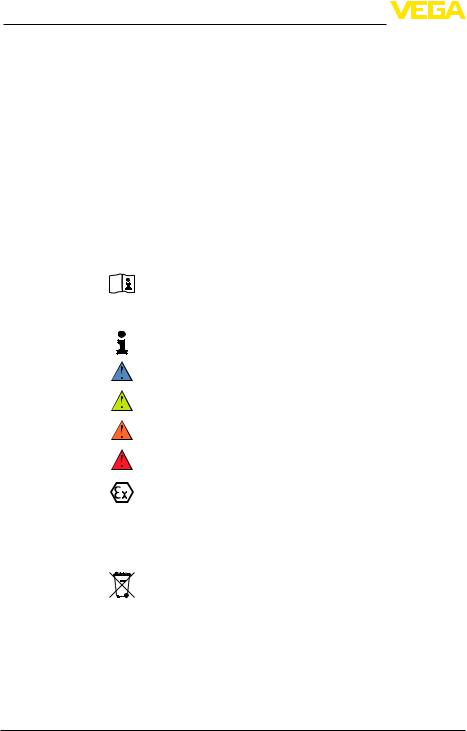
1 About this document
1 About this document
1.1Function
This instruction provides all the information you need for mounting, connection and setup as well as important instructions for maintenance, fault rectification, the exchange of parts and the safety of the user. Please read this information before putting the instrument into operation and keep this manual accessible in the immediate vicinity of the device.
1.2Target group
This operating instructions manual is directed to trained personnel.
The contents of this manual must be made available to the qualified personnel and implemented.
1.3Symbols used
Document ID
This symbol on the front page of this instruction refers to the Document ID. By entering the Document ID on www.vega.com you will reach the document download.
Information, note, tip: This symbol indicates helpful additional information and tips for successful work.
Note: This symbol indicates notes to prevent failures, malfunctions, damage to devices or plants.
Caution: Non-observance of the information marked with this symbol may result in personal injury.
Warning: Non-observance of the information marked with this symbol may result in serious or fatal personal injury.
Danger: Non-observance of the information marked with this symbol results in serious or fatal personal injury.
Ex applications
This symbol indicates special instructions for Ex applications.
•ListThe dot set in front indicates a list with no implied sequence.
1Sequence of actions
Numbers set in front indicate successive steps in a procedure.
Battery disposal
This symbol indicates special information about the disposal of batteries and accumulators.
<![if ! IE]><![endif]>210318-EN-58347
4 |
VEGAPULS C 23 • Two-wire 4 … 20 mA/HART |

<![endif]>58347-EN-210318
2 For your safety
2 For your safety
2.1Authorised personnel
All operations described in this documentation must be carried out only by trained, qualified personnel authorised by the plant operator.
During work on and with the device, the required personal protective equipment must always be worn.
2.2Appropriate use
VEGAPULS C 23 is a sensor for continuous level measurement.
You can find detailed information about the area of application in chapter " Product description".
Operational reliability is ensured only if the instrument is properly used according to the specifications in the operating instructions manual as well as possible supplementary instructions.
2.3Warning about incorrect use
Inappropriate or incorrect use of this product can give rise to applica- tion-specific hazards, e.g.vessel overfill through incorrect mounting or adjustment. Damage to property and persons or environmental contamination can result. Also, the protective characteristics of the instrument can be impaired.
2.4General safety instructions
This is a state-of-the-art instrument complying with all prevailing regulations and directives. The instrument must only be operated in a technically flawless and reliable condition.The operator is responsible for the trouble-free operation of the instrument. When measuring aggressive or corrosive media that can cause a dangerous situation if the instrument malfunctions, the operator has to implement suitable measures to make sure the instrument is functioning properly.
The safety instructions in this operating instructions manual, the national installation standards as well as the valid safety regulations and accident prevention rules must be observed by the user.
For safety and warranty reasons, any invasive work on the device beyond that described in the operating instructions manual may be carried out only by personnel authorised by the manufacturer. Arbitrary conversions or modifications are explicitly forbidden.For safety reasons, only the accessory specified by the manufacturer must be used.
To avoid any danger, the safety approval markings and safety tips on the device must also be observed.
The low transmitting power of the radar sensor is far below the internationally approved limits. No health impairments are to be expected with intended use. The band range of the measuring frequency can be found in chapter " Technical data".
VEGAPULS C 23 • Two-wire 4 … 20 mA/HART |
5 |

2 For your safety
2.5Modes for worldwide use
Country specific settings for the radar signals are determined via the operating mode. The operating mode must be set in the operating menu via the respective adjustment tool at the beginning of the setup (see chapter " Setup" resp. " Menu overview".
Caution:
Operating the device without selecting the appropriate country group constitutes a violation of the regulations of the radio approvals of the respective country.
Further information can be found in the document " Regulations for radar level measuring instruments with radio licenses" on our homepage.
2.6Installation and operation in the USA and Canada
This information is only valid for USA and Canada. Hence the following text is only available in the English language.
Installations in the US shall comply with the relevant requirements of the National Electrical Code (ANSI/NFPA 70).
Installations in Canada shall comply with the relevant requirements of the Canadian Electrical Code
A Class 2 power supply unit has to be used for the installation in the USA and Canada.
<![if ! IE]><![endif]>210318-EN-58347
6 |
VEGAPULS C 23 • Two-wire 4 … 20 mA/HART |

<![endif]>58347-EN-210318
3 Product description
3 Product description
3.1Configuration
Scope of delivery |
The scope of delivery encompasses: |
||
|
• |
Radar sensor |
1) |
|
• |
Counter nut G1 |
|
|
• |
Information sheet " Documents and software" with: |
|
|
–– Instrument serial number |
||
|
• |
–– QR code with link for direct scanning |
|
|
with:Information sheet " PINs and Codes" (with Bluetooth versions) |
||
|
• |
–– Bluetooth access code |
|
|
with:Information sheet " Access protection" (with Bluetooth versions) |
||
|
|
–– Bluetooth access code |
|
–– Emergency Bluetooth unlock code –– Emergency device code
The further scope of delivery encompasses:
•Documentation
––Ex-specific " Safety instructions" (with Ex versions)
––Radio licenses
––If necessary, further certificates
Note:
Optional instrument features are also described in this operating instructions manual. The respective scope of delivery results from the order specification.
Scope of this operating |
This operating instructions manual applies to the following instrument |
|
instructions |
versions: |
|
|
• |
Hardware version from 1.0.0 |
|
• |
Software version from 1.2.0 |
1) With G thread |
|
VEGAPULS C 23 • Two-wire 4 … 20 mA/HART |
7 |
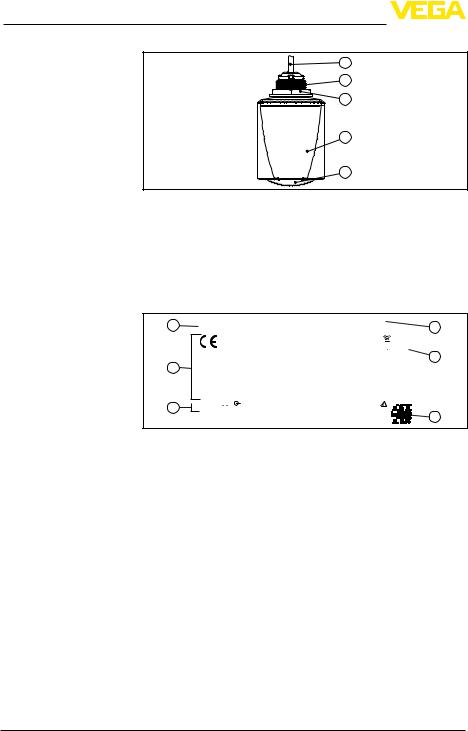
3 Product description
Constituent parts
|
|
5 |
|
|
4 |
|
|
3 |
|
|
2 |
|
|
1 |
|
Fig. 1: Components of VEGAPULS C 23 |
|
|
1 |
Radar antenna |
|
2 |
Electronics housing |
|
3 |
Mounting thread |
|
4 |
Counter nut |
|
5 |
Connection cable |
Type label |
The type label contains the most important data for identification and |
|
|
use of the instrument. |
|
1
2
3
<![endif]>0044

 12...35V
12...35V  15m
15m
VEGAPULS C 2. |
RA - 222 2N 123 |
6 |
||||||||
s/n 12345678 |
||||||||||
4...20mA HART |
|
|
|
123456 |
5 |
|||||
|
|
|
||||||||
|
|
|
|
|
|
|
|
|||
MWP 3bar (300kPa) |
L=5m |
|
|
|
|
|
||||
|
|
|
|
|
|
|
||||
IP66/IP68, TYPE 6P |
PVDF |
1½ NPT / 1 NPT www.vega.com |
|
|
|
|
|
|
4 |
|
|
|
D-77761 SCHILTACH, |
|
|
|
|
||||
|
|
Made in Germany |
|
|
|
|
||||
Fig. 2: Layout of the type label (example)
1Instrument type
2Field for approvals
3Technical data
4QR code for device documentation
5Bluetooth access code
6Order number
Documents and software Move to " www.vega.com" and enter in the search field the serial number of your instrument.
There you can find the following information about the instrument:
•Order data
•Documentation
•Software
Alternatively, you can find all via your smartphone:
•Scan the QR-code on the type label of the device or
•Enter serial number manually in the VEGA Tools app (available free of charge in the respective stores)
8 |
VEGAPULS C 23 • Two-wire 4 … 20 mA/HART |
<![endif]>210318-EN-58347

|
|
|
|
3 Product description |
|
|
3.2 |
Principle of operation |
|
Application area |
VEGAPULS C 23 is a radar sensor for non-contact, continuous level |
|||
|
|
measurement. It is suitable for liquids and solids in practically all |
||
|
|
industries. |
||
Functional principle |
The instrument emits a continuous, frequency-modulated radar signal |
|||
|
|
through its antenna.The emitted signal is reflected by the medium |
||
|
|
and received by the antenna as an echo with modified frequency.The |
||
|
|
frequency change is proportional to the distance and is converted into |
||
|
|
the level. |
||
|
|
3.3 |
Adjustment |
|
Wireless adjustment |
Devices with integrated Bluetooth module can be adjusted wirelessly |
|||
|
|
via standard adjustment tools: |
||
|
|
• |
Smartphone/tablet (iOS or Android operating system) |
|
|
|
• |
PC/notebook with Bluetooth USB adapter (Windows operating |
|
|
|
|
system) |
|
2
1 |
3 |
Adjustment via the signal cable
Fig. 3: Wireless connection to standard operating devices with integrated Bluetooth LE
1Sensor
2Smartphone/Tablet
3PC/Notebook
Devices with signal output 4 … 20 mA/HART can also be operated via a signal cable. This is done via an interface adapter and a PC/ notebook using DTM/PACTware.
<![endif]>58347-EN-210318
VEGAPULS C 23 • Two-wire 4 … 20 mA/HART |
9 |
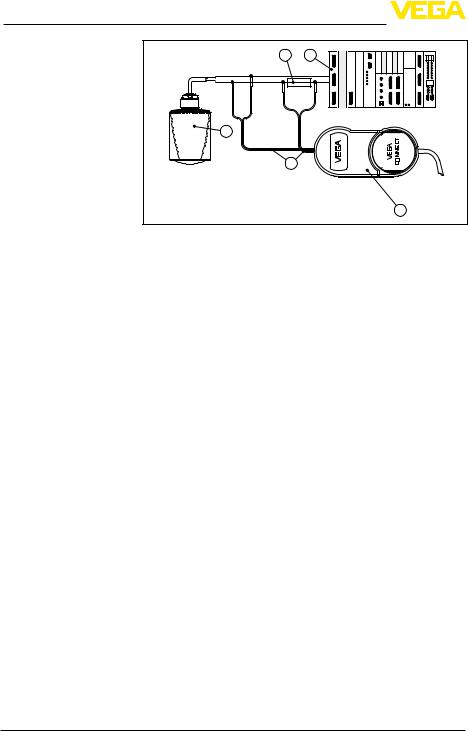
3 Product description
2 |
4 |
|
1 |
|
|
|
<![if ! IE]> <![endif]>TWIST |
<![if ! IE]> <![endif]>USB |
3 |
|
OPEN |
|
|
|
|
|
5 |
Fig. 4: Connecting the PC to the signal cable
1 Sensor
2 HART resistance 250 Ω (optional depending on evaluation)
3Connection cable with 2 mm pins and terminals
4Voltage supply
5Interface adapter VEGACONNECT
6PC/notebook with DTM/PACTware
|
3.4 Packaging, transport and storage |
Packaging |
Your instrument was protected by packaging during transport. Its |
|
capacity to handle normal loads during transport is assured by a test |
|
based on ISO 4180. |
|
The packaging consists of environment-friendly, recyclable card- |
|
board. For special versions, PE foam or PE foil is also used. Dispose |
|
of the packaging material via specialised recycling companies. |
Transport |
Transport must be carried out in due consideration of the notes on the |
|
transport packaging. Nonobservance of these instructions can cause |
|
damage to the device. |
Transport inspection |
The delivery must be checked for completeness and possible transit |
|
damage immediately at receipt. Ascertained transit damage or con- |
|
cealed defects must be appropriately dealt with. |
Storage
Storage and transport temperature
10
Up to the time of installation, the packages must be left closed and stored according to the orientation and storage markings on the outside.
Unless otherwise indicated, the packages must be stored only under the following conditions:
•Not in the open
•Dry and dust free
•Not exposed to corrosive media
•Protected against solar radiation
•Avoiding mechanical shock and vibration
•Storage and transport temperature see chapter " Supplement - Technical data - Ambient conditions"
VEGAPULS C 23 • Two-wire 4 … 20 mA/HART
<![endif]>210318-EN-58347

|
|
3 Product description |
|
|
• Relative humidity 20 … 85 % |
|
|
3.5 Accessories |
Flanges |
Screwed flanges are available in different versions according to the |
|
|
|
following standards: DIN 2501, EN 1092-1, BS 10, ASME B 16.5, |
|
|
JIS B 2210-1984, GOST 12821-80. |
Welded sockets and |
Welded sockets are used to connect the devices to the process. |
|
adapters |
Threaded adapters enable simple adaptation of devices with stand- |
|
|
|
ard threaded fittings, e.g.to process-side hygiene connections. |
Mounting strap |
The mounting accessories are used for stable mounting of the device |
|
|
|
at the measuring point. The parts are available in various versions and |
|
|
sizes. |
<![endif]>58347-EN-210318
VEGAPULS C 23 • Two-wire 4 … 20 mA/HART |
11 |

4 Mounting
4 Mounting
Ambient conditions
Process conditions
4.1General instructions
The instrument is suitable for standard and extended ambient conditions acc. to DIN/EN/IEC/ANSI/ISA/UL/CSA 61010-1. It can be used indoors as well as outdoors.
Note:
For safety reasons, the instrument must only be operated within the permissible process conditions.You can find detailed information on the process conditions in chapter " Technical data" of the operating instructions or on the type label.
Hence make sure before mounting that all parts of the instrument exposed to the process are suitable for the existing process conditions.
These are mainly:
•Active measuring component
•Process fitting
•Process seal
Process conditions in particular are:
•Process pressure
•Process temperature
•Chemical properties of the medium
•Abrasion and mechanical influences
|
4.2 Mounting versions |
|||||||||||||||||||
Mounting bracket |
For the wall mounting, a mounting bracket with opening for thread G1 |
|||||||||||||||||||
|
is recommended. The mounting of the device in the bracket is carried |
|||||||||||||||||||
|
out via the supplied G1 counter nut of plastic. Take note of chapter " |
|||||||||||||||||||
|
Mounting instructions" for the recommended distance to the wall. |
|||||||||||||||||||
|
|
|
|
|
|
|
|
|
|
|
|
|
|
|
|
|
|
|
|
|
|
|
|
|
|
|
|
|
|
|
|
|
|
|
|
|
|
|
|
|
|
|
|
|
|
|
|
|
|
|
|
|
|
|
|
|
|
|
|
|
|
|
|
|
|
|
|
|
|
|
|
|
|
|
|
|
|
|
|
|
|
|
|
|
|
|
|
|
|
|
|
|
|
|
|
|
|
|
|
|
|
|
|
|
|
|
|
|
|
|
|
|
|
|
|
|
|
|
|
|
|
|
|
|
|
|
|
|
|
|
|
|
|
|
|
|
|
|
|
|
|
|
|
|
|
|
|
|
|
|
|
|
|
|
|
|
|
|
|
|
|
|
|
|
|
|
|
> 200 mm (7.87")
Fig. 5: Mounting via a mounting bracket
12 |
VEGAPULS C 23 • Two-wire 4 … 20 mA/HART |
<![endif]>210318-EN-58347

|
4 Mounting |
|
|
4.3 Mounting instructions |
|
Polarisation |
Radar sensors for level measurement emit electromagnetic waves. |
|
|
The polarization is the direction of the electrical component of these |
|
|
waves. |
|
|
The position of the polarisation is in the middle of the type label on the |
|
|
instrument. |
|
|
|
|
|
|
|
|
|
|
|
|
|
|
|
|
|
|
|
|
|
|
|
|
|
|
|
|
|
|
|
|
|
|
|
|
|
|
|
|
|
|
|
|
|
|
|
|
|
|
|
|
|
|
|
|
|
|
|
|
|
|
|
|
|
|
|
|
|
|
|
|
|
|
|
|
|
|
|
|
|
|
|
1 |
|
|
|
|
|
|
|
|
|
|
|
|
|
|
|
|
|
|
|
|||
|
|
|
|
|
|
|
|
|
|
|
|
|
|
|
|
|
|
|||
|
|
|
|
|
|
|
|
|
|
|
|
|
|
|
|
|
|
|
|
|
|
|
|
|
|
|
|
|
|
|
|
|
|
|
|
|
|
|
|
||
|
|
|
|
Fig. 6: Position of the polarisation |
||||||||||||||||
|
|
|
|
1 Middle of the type label |
||||||||||||||||
|
|
|
|
Note: |
||||||||||||||||
|
|
|
|
When the device is rotated, the direction of polarization changes and |
||||||||||||||||
|
|
|
|
hence the influence of the false echo on the measured value.Please |
||||||||||||||||
|
|
|
|
|||||||||||||||||
|
|
|
|
keep this in mind when mounting or making changes later. |
||||||||||||||||
Installation position |
|
|
When mounting the device, keep a distance of at least 200 mm |
|||||||||||||||||
|
|
|
|
(7.874 in) from the vessel wall. If the device is installed in the center |
||||||||||||||||
|
|
|
|
of dished or round vessel tops, multiple echoes can arise. However, |
||||||||||||||||
|
|
|
|
these can be suppressed by an appropriate adjustment (see chapter |
||||||||||||||||
|
|
|
|
" Setup"). |
||||||||||||||||
|
|
|
|
If you cannot maintain this distance, you should carry out a false |
||||||||||||||||
|
|
|
|
signal suppression during setup. This applies particularly if buildup on |
||||||||||||||||
|
|
|
|
the vessel wall is expected. In such cases, we recommend repeating |
||||||||||||||||
|
|
|
|
the false signal suppression at a later date with existing buildup. |
||||||||||||||||
|
|
|
|
|
|
|
|
|
|
|
|
|
|
|
|
|
|
|
|
|
|
|
|
|
|
|
|
|
|
|
|
|
|
|
|
|
|
|
|
|
|
> 200 mm  (7.87")
(7.87")
Fig. 7: Mounting of the radar sensor on round vessel tops
In vessels with conical bottom it can be advantageous to mount the device in the centre of the vessel, as measurement is then possible down to the bottom.
<![if ! IE]><![endif]>58347-EN-210318
VEGAPULS C 23 • Two-wire 4 … 20 mA/HART |
13 |
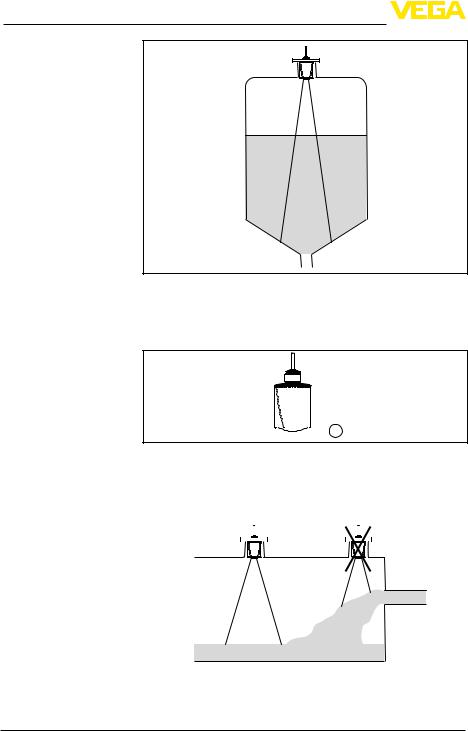
4 Mounting
|
Fig. 8: Mounting of the radar sensor on vessels with conical bottom |
Reference plane |
The centre of the antenna lens is the beginning of the measuring |
|
range and at the same time the reference plane for the min./max. |
|
adjustment, see following diagram: |

 1
1
Fig. 9: Reference plane 1 Reference plane
Inflowing medium |
Do not mount the instruments in or above the filling stream.Make sure |
||||||
|
that you detect the medium surface, not the inflowing product. |
||||||
|
|
|
|
|
|
|
|
|
|
|
|
|
|
|
|
|
|
|
|
|
|
|
|
Fig.10:Mounting of the radar sensor with inflowing medium
14 |
VEGAPULS C 23 • Two-wire 4 … 20 mA/HART |
<![endif]>210318-EN-58347

|
4 Mounting |
Nozzle |
For nozzle mounting, the nozzle should be as short as possible and |
|
its end rounded.This reduces false reflections from the nozzle. |
|
The antenna edge should protrude at least 5 mm (0.2 in) out of the |
|
nozzle. |
|
<![if ! IE]> <![endif]>≥ 5 mm (0.20") |
|
Fig. 11: Recommended socket mounting of VEGAPULS C 23 |
|
If the reflective properties of the medium are good, you can mount |
|
VEGAPULS C 23 on sockets longer than the antenna. The socket end |
|
should be smooth and burr-free, if possible also rounded. |
|
Note: |
|
When mounting on longer nozzles, we recommend carrying out a |
|
false signal suppression (see chapter " Parameter adjustment"). |
|
You will find recommended values for socket heights in the following |
|
illustration or the table. The values come from typical applications. |
|
Deviating from the proposed dimensions, also longer sockets are |
|
possible, however the local conditions must be taken into account. |
<![endif]>58347-EN-210318
<![endif]>h
|
|
|
|
|
|
d |
|
|
|
|
|
|
|
|
|
|
|
|
|
|
|
|
|
|
|
|
|
|
|
|
|
|
||||||
|
Fig. 12: Socket mounting with deviating socket dimensions |
|
||||||||||
|
|
|
|
|
|
|
|
|
|
|
||
|
Socket diameter d |
|
|
|
|
Socket length h |
|
|||||
|
80 mm |
|
3" |
|
|
|
≤ 300 mm |
≤ 11.8 in |
||||
|
100 mm |
|
4" |
|
|
|
≤ 400 mm |
≤ 15.8 in |
||||
|
150 mm |
|
6" |
|
|
|
≤ 600 mm |
≤ 23.6 in |
||||
Vessel installations |
The mounting location of the radar sensor should be a place where no |
|||||||||||
|
other equipment or fixtures cross the path of the radar signals. |
|||||||||||
|
Vessel installations, such as e.g. ladders, limit switches, heating spi- |
|||||||||||
|
rals, struts, etc., can cause false echoes and impair the useful echo. |
|||||||||||
|
Make sure when planning your measuring point that the radar sensor |
|||||||||||
|
has a " clear view" to the measured product. |
|
||||||||||
|
In case of existing vessel installations, a false signal suppression |
|||||||||||
|
should be carried out during setup. |
|
|
|
|
|
|
|||||
|
|
|
|
|
|
|
|
|
|
|
|
|
VEGAPULS C 23 • Two-wire 4 … 20 mA/HART |
|
|
|
|
|
|
|
|
|
15 |
||

4 Mounting
If large vessel installations such as struts or supports cause false echoes, these can be attenuated through supplementary measures.
Small, inclined sheet metal baffles above the installations " scatter" the radar signals and prevent direct interfering reflections.
|
|
|
|
|
|
|
|
|
|
|
|
|
|
|
|
|
|
|
|
|
|
|
|
|
|
|
|
|
|
|
|
|
|
|
|
|
|
|
|
|
|
|
|
|
|
|
|
|
|
|
|
|
|
|
|
|
|
|
|
|
|
|
|
|
|
|
|
|
|
|
|
|
|
|
|
|
|
|
Fig.13:Cover flat, large-area profiles with deflectors |
|||||||||||
Alignment - Liquids |
In liquids, direct the device as perpendicular as possible to the me- |
|||||||||||
|
dium surface to achieve optimum measurement results. |
|||||||||||
|
|
|
|
|
|
|
|
|
|
|
|
|
|
|
|
|
|
|
|
|
|
|
|
|
|
|
|
|
|
|
|
|
|
|
|
|
|
|
Fig. 14: Alignment in liquids
Orientation - Bulk solids In order to measure as much of the vessel volume as possible, the device should be aligned so that the radar signal reaches the lowest level in the vessel. In a cylindrical silo with conical outlet, the sensor is mounted anywhere from one third to one half of the vessel radius from the outside wall (see following drawing).
<![if ! IE]><![endif]>210318-EN-58347
16 |
VEGAPULS C 23 • Two-wire 4 … 20 mA/HART |
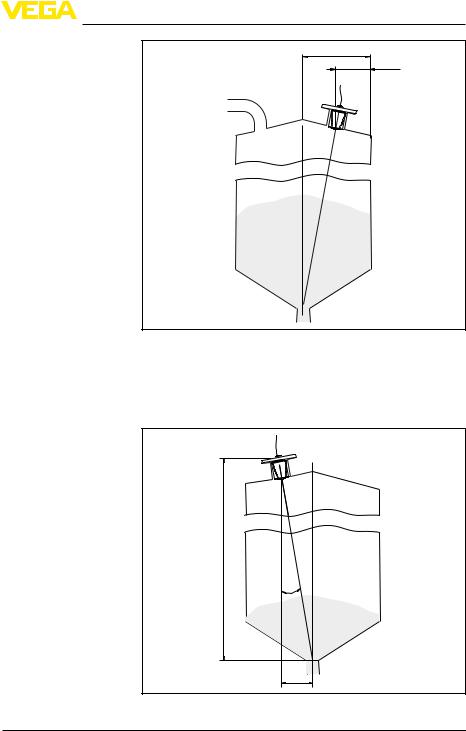
4 Mounting
r
1/3r...1/2 r
Fig. 15: Mounting position and orientation
Swivelling holder
Due to optimum socket design, the device can be easily aligned to the vessel centre. The necessary angle of inclination depends on the vessel dimensions. It can be easily checked with a suitable bubble tube or mechanic's level on the sensor.
<![endif]>58347-EN-210318
| <![if ! IE]> <![endif]>d |
α |
a |
Fig. 16: Proposal for installation after orientation VEGAPULS C 23
VEGAPULS C 23 • Two-wire 4 … 20 mA/HART |
17 |

4 Mounting
Agitators
Foam generation
18
The following table shows the necessary angle of inclination. It depends on the measuring distance and the distance "a" between vessel centre and installation position.
Distance d (m) |
2° |
4° |
6° |
8° |
10° |
2 |
0.1 |
0.1 |
0.2 |
0.3 |
0.4 |
4 |
0.1 |
0.3 |
0.4 |
0.6 |
0.7 |
6 |
0.2 |
0.4 |
0.6 |
0.8 |
1.1 |
8 |
0.3 |
0.6 |
0.8 |
1.1 |
1.4 |
10 |
0.3 |
0.7 |
1.1 |
1.4 |
1.8 |
15 |
0.5 |
1 |
1.6 |
2.1 |
2.6 |
20 |
0.7 |
1.4 |
2.1 |
2.8 |
3.5 |
25 |
0.9 |
1.7 |
2.6 |
3.5 |
4.4 |
30 |
1 |
2.1 |
3.2 |
4.2 |
5.3 |
Example:
In a vessel 20 m high, the installation position of the sensor is 1.4 m from the vessel centre.
The necessary angle of inclination of 4° can be read out from this table.
If there are agitators in the vessel, a false signal suppression should be carried out with the agitators in motion. This ensures that the interfering reflections from the agitators are saved with the blades in different positions.
Fig. 17: Agitators |
|
|
Through the action of filling, stirring and other processes in the vessel, |
<![if ! IE]> <![endif]>58347 |
|
compact foams which considerably damp the emitted signals may |
||
form on the medium surface. |
<![if ! IE]> <![endif]>- |
|
If foams lead to measurement errors, you should use the biggest pos- |
<![if ! IE]> <![endif]>-EN |
|
| <![if ! IE]> <![endif]>210318 |
||
sible radar antennas or sensors with guided radar. |
||
|
||
VEGAPULS C 23 • Two-wire 4 … 20 mA/HART |
|
